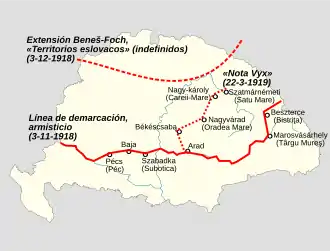Armistice of Belgrade
The Armistice of Belgrade was signed on 13 November 1918 between the First Hungarian Republic of Mihály Károlyi and the Allied Powers in Belgrade. It was later not respected by the allies, which led to the collapse of the First Hungarian Republic and its replacement by the Hungarian Soviet Republic in March 1919.

Prelude
After 4 years of heavy fighting, the armies of the Central Powers in Southern Europe collapsed from the second half of September 1918 when the French and Serb armies managed a breakthrough at the Battle of Dobro Pole.
On 29 September 1918 , the allies signed the Armistice of Salonica with effectively ended Bulgaria's participation in World War I.
This left the Balkans wide open for the French and Serb forces of the Macedonian front, which advanced almost unopposed through Serbia and liberated Belgrade on 1 November.
Around the same time, the Ottoman Empire signed the Armistice of Mudros on 30 October, the disintegrating Austro-Hungarian Army in Northern Italy signed the Armistice of Villa Giusti on 3 November and Romania reentered the war on the sides of the allies on 10 November.
Also on 10 November, the French Army crossed the Danube river, advancing in the direction of the heartland of Hungary. Count Károlyi, leading the Hungarian government, had no option but to accept the invitation of French General Louis Franchet d'Espèrey to come to Belgrade to sign an armistice.
Terms of the Armistace
- Reduction of the new Hungarian Army to 8 divisions.
- The Hungarian Army was to withdraw behind the line Beszterce - Marosvásárhely - Arad - Pécs - Drava River.
- Civil authorities would remain in place and the territory would remain Hungarian until a final general peace treaty was concluded.
- All allied prisoners of war in Hungary were to be released.
Sources
- Krizman, Bogdan (1970). «The Belgrade Armistice of 13 November 1918». The Slavonic and East European Review 48 (110): 67-87.
- Macartney, C. A. (2001). Hungary and Her Successors: The Treaty of Trianon and Its Consequences, 1919-1937. Simon Publications. p. 504. ISBN 9781931313865.
- Mócsy, István I. (1983). The Uprooted: Hungarian Refugees and Their Impact on Hungary's Domestic Politics, 1918-1921. East European Monographs. p. 252. ISBN 9780880330398.
- Pastor, Peter (1976). Hungary Between Wilson and Lenin. East European Monograph. p. 191. ISBN 9780914710134.
- VV., AA. (1988). Király, Béla K.; Pastor, Peter, eds. War and society in East Central Europe Vol. 20 Revolutions and interventions in Hungary and its neighbor states, 1918 - 1919. Columbia University Press. p. 530. ISBN 9780880331371.